Am I The Only One Frustrated?
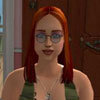 kj_54e8eded70
Posts: 29
kj_54e8eded70
Posts: 29
I've been a devoted Daz user and customer for over 15 years, and don't expect that will change - but it's slowing down like their Iray renderer - and that's the main reason.
Daz has a real penchant for fixing things that aren't broken. I don't know what was wrong with the original Genesis figure, and now they're up to Genesis 8 with very limited backward compatibility - and there is almost no support or new products for Genesis 2 or earlier (though a lot of people still seem to like Victoria 4, cumbersome and limited as she seems now).
And that's part of the problem.
The other thing is Iray. Was this really an improvement over 3Delight? It certainly takes longer (I have a fairly powerful machine, and an Iray render can take hours - if it renders at all). I understood nearly all of the 3Delight settings, but the Iray ones are incomprehensible to anybody but a professional Hollywood lighting director. And the biggest frustration is there are certain props and figures (mainly hair) that I cannot use at all in 3Delight!
Here is an example: This is a prop (the Mobile Home) with Iray textures and settings. The scene has a photo backdrop (see unrendered scene). Yet, observe what happens when I attempt to render the scene! I tried playing with the "Cutout opacity"( How is that different from just plain "opacity"?), but I could not get the background to show. Even when I hid windows in the Scene window.
The only workaround I can think of is to render the scene twice, once with and once without the building, the FIIP it.
It would be nice not to have to do that, however. Is there any way to change the textures? Reduce their resolution? Most of my renders wind up as the basis of cartoons anyway, so detail is not that much of a concern.
On the positive side, I like the slight reflection in the glass - something I've never achieved successfully with 3Delight.
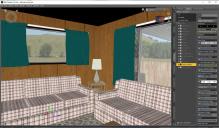

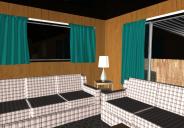

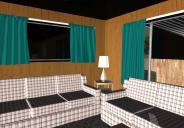

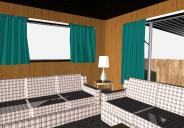

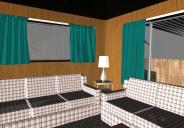



Comments
When moving from 3dlight to iray you have to up the lighting output by magnitudes of thousands. I haven't been using Daz for as long as you, only about maybe 3 years, where the last 2 I really dug in deep. So even though I was very confused with the different rendering options I quickly realized Iray was the only way I wanted to go. Spending a good amount of time exploring and experimenting I think was the key for me to learn it. Also reading thorugh the forums here to find out what I was unsure certain things did, and find out how other people render and ways they use Daz.
If your system can handle it, I suggest switching to low resolution nvidia display, this lets you see how the scene will actually look without waiting on a render.
As far as your scene goes maybe posting your render settings would help to find what's going on.
The unified base figure, while great in theory, made creating content for Genesis very complex.
That's always the case after a while when a new figure is released: most customers have moved to the new figure and don't buy content for previous figures anymore, so product for them don't sell much anymore, so vendors stop making new ones because they need to make products which actually bring them money and enable them to pay for their rent and food.
There are converters which enable you to use content made for newer figures on the older ones though.
Victoria 4 is the last figure natively compatible with Poser that Daz released, and for a long time there wasn't any real alternative for Poser users, so they kept using her and buying new content created for her.
...do you not have an Nvidia GPU card?
I understand about the long render times, for several years I was rendering on the CPU and had to let the process run overnight. I now have a pre-owned Titan-X and render times are down to minutes instead of hours. Even for just doing a "proof render" of a single character with a studio light HDR set se took between 25 and 40 minutes whereas now it takes less than a minute and rarely more than two.
I've been around for about the same amount of time and it has taken a while to get use to Iray (I also dabbled with Reality/Lux for a bit). Still wrangling with lighting, particularly for indoor scenes as they involve far more ray bounces than exterior scenes. and thus take longer to render even with a fairly powerful GPU.
The best way to think about Iray is from a photographer's aspect as in the tone mapping tab you will notice several settings that use camera terminology On a real camera ISO is the film speed, f-Stop is the aperture (which is adjusted to let in more or less light) .and shutter speed. In lower light situations the f-Stop is usually al lower value (more open) and the shutter speed is set slower
For Iray rendering it is important to check the environment mode unless it is a full interior scene with no windows to the outside, I use the Sun-Sky Only mode rather than an HDRI as I find it more accurate, particularly for more realistic shadows. This setting also creates a "skydome" which should be set to "Infinite Sphere" and Draw Dome should be set to "On" Instead of the default settings (which are set to time and real world location) there is a much more simpler manual control which can be found in Render Presets in the Content Library tab. Clikc on teh expansion arrow to open the Iray folder and there will be an option called "Sun Dial Set". This will let to you manually position the "sun" where you want it. Clicking on that will place a handle (that looks like a yellow arrow with a dashed line to the ground at the centre of your scene) This indicates where the sun is in the sky. It wil lalso add the "Sun Dial" to the scene tab. Opening this up it and clicking on "Sun Chain" will reveal two sliders in the parameter tab, one for sun's elevation and the other for the sun's azimuth (rotation). These will allow you position the Iray sun wherever you want it.
Attached is an interior scene I did that also has elements on the outside which can be seen through windows. Granted this set also has skylight windows as it is an enclosed garden. so the sunlight illuminates both. I also added what is referred to as a "soft box" light (a plane primitive with the emission channel turned on which is above and behind the camera) to add a bit more ambient light inside for the characters.as well as some DOF. I also added a slight bit or "warming" effect in post.
or adjust Tone Mapping to match the lighting, as with using a physical camera.
Was the backdrop on a bit of geometry - e.g. a skydome? Iray doesn't - in Photoreal mode - have an option to turn off shadow casting the way 3Delight does. Another possibility to check is the Thin Walled setting for the glass in the Surfaces pane.
Cutout Opacity is intended fro just that - making a cutout on a surface. it isn't intended for making items present but see-through, the expectation is that other properties (translucence) will be used for that.
I understand where you are coming from, but really prefer the look of Iray to 3delight. I found 3dl slow if you set the lighting up right anyway. By setting the iterations down to 500 or even 50 with post process smoothing enable, I can render most images in a few minutes. It's not realtime, but the quality is worth it to me. Compare that to the render quality of an out of the box iClone render and you will see there is no contest. I know iclone can do iray now, but last time I looked it was slower than Daz with less control.
Thanks - how do I find those settings (specifically interations and post process smoothing)? I really know very little about Iray (other than it seems far more complicated and slower, but if this can fix it, I could be totally on board with it!)
- Just a photo
- so, the "Translucency Weight" option? There is also a translucency color that disappears when I turn it to zero.
Render Settings pane>Editor tab.
A photo as a backdrop (through the Environment pane) or applied to a plane?
When a strength slider is zeroed in the Surfaces pane using the Iray Uber Base shader all of its sub-properties are hidden.
There's nothing forcing you to use iray or genesis 8. If you're fine with genesis and 3delight just go with it. The old assets are in the shop down to V4.
And I do. My problem is the newer assets such as sets and hair reflecting historical periods, which I use extensively in my renders
https://www.daz3d.com/rssy-iray-to-3delight-converter-and-merchant-resource
Don't worry, set your Render Settings like this, you will love iray:
Iray is definitely a learning curve. Some tricks I've learned that work pretty well when you are trying to use an image as an outdoor background while rendering an indoor scene, and see it through the windows:
Sorry if I'm telling you stuff you already know. These were a few of the things that stumped me when I was first learning Iray.
Oh one more thing - a real gotcha - in texture shaded mode, looking through an Iray surface with transparency (like a window) will make any Iray surface that also has transparency (like hair) disappear. If your scenery plane has any transparency other than zero, you won't be able to see it through the window until you preview it in Iray. Move the camera through the window, and it will magically appear.
You are welcome. This settings can deal with 90% cases, unless for nearby close up (e.g. skin pore and details), then should turn off 'Post Denoiser' and enlarge the Max Samples value to avoid noiser.
My frustration is the more you add content slows loading times to a crawl. For a buisness that makes it's revenue on seliing content. This seems conter productive. I feel like I will be forced to rebuild runtime from the start.